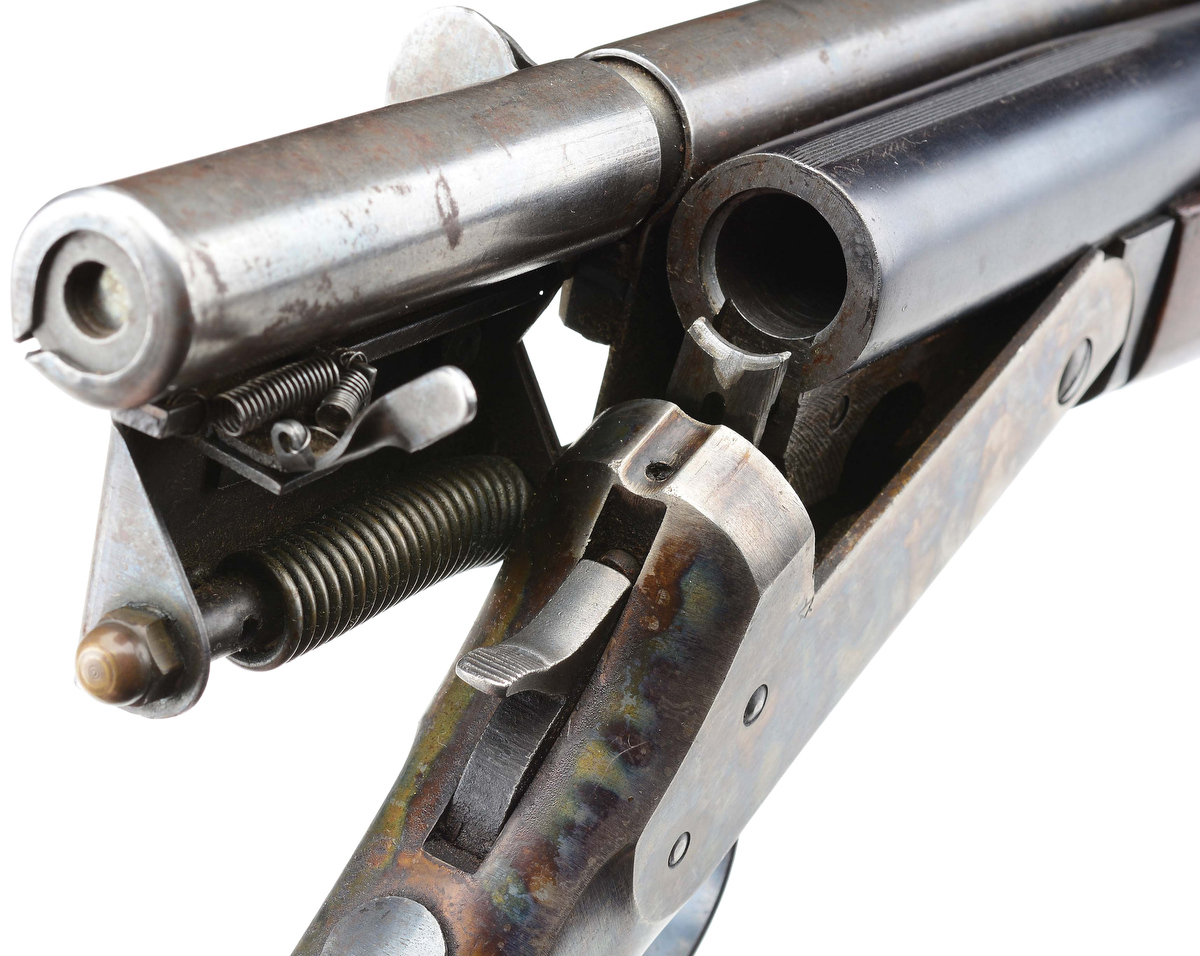By Robert Bruce
“When I was in Iraq with 3rd Light Armored Recon, there were a lot of issues in uncovering weapons and not knowing if they worked, if they were used recently or where they came from. We knew the basics, like what an AK47 looked like. We could take it apart but didn’t know very well how to operate it, we didn’t know the capabilities and limitations. For example, was it accurate to 200 or 300 meters? You really don’t know until you actually get down to brass tacks; zero the weapon, utilize it on a fixed course of fire using the weapon the way it’s intended.” Sergeant Alex C. Deykerhoff, student, FWIC
We talked with Sgt. “D” and other Marines at the beginning and end of an intensive three week course at MCB Quantico’s Weapons Training Battalion in practical aspects of infantry weapons commonly used by allied and insurgent forces. Through classroom instruction, hands-on drills, live fire, and teach-backs where they had to demonstrate the ability to train others, more than two dozen Marines from all over the Corps were becoming the foreign weapons “go-to-guys” for their home units.
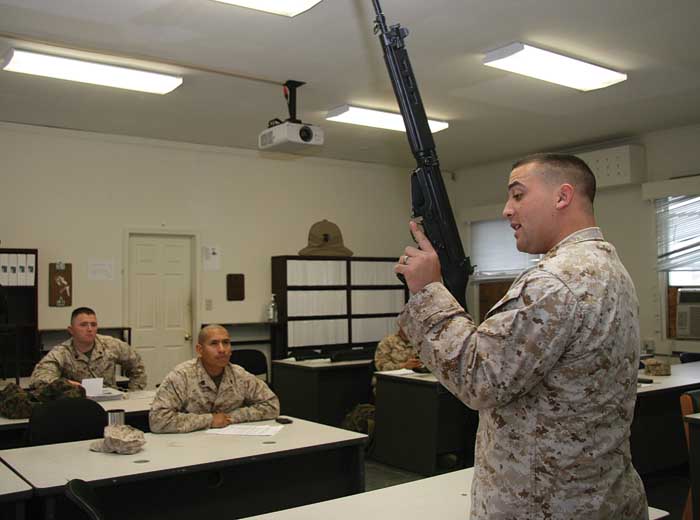
Gunner David E. Rogers, Officer-in-Charge of Weapons Training Battalion’s Small Arms Weapons Instructor School, explained that the Corps was providing this unusual training, “to allow commanders to create cadres to further instruct their Marines on the most commonly found foreign weapons.”
In Deykerhoff’s case, he would be returning to his present assignment as a Rifle Squad Leader in 3rd Battalion, 5th Marine Regiment at Camp Pendleton, California. His unit was preparing for deployment to Afghanistan, he said, and they were counting on him to teach his fellow Marines what he had learned at FWIC.
This was echoed by other students we spoke with who would be taking their new-found skills back to Force Recon, MARSOC, and several infantry regiments.
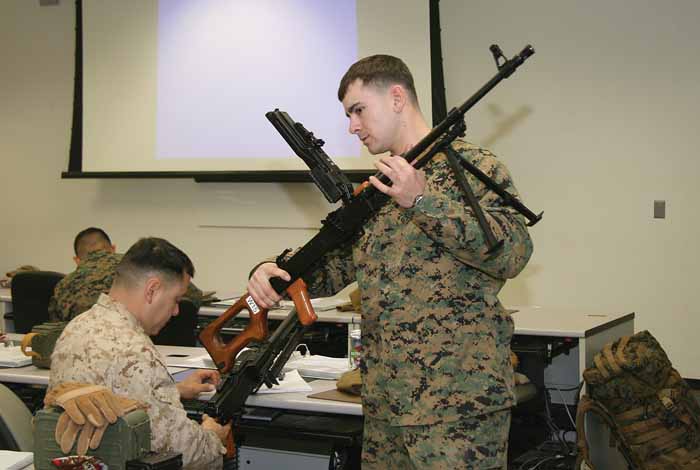
While some might question the diversion of critical resources and training time to something not directly related to traditional combat skills with standard-issue weapons, justification is readily found in the realities of today’s operational environment.
Working Side by Side
It bears repeating that the Marine Corps is widely regarded as the most serious of America’s Armed Forces when it comes to the deadly business of war fighting. “Every Marine is a Rifleman” is an enduring truth, validated daily in training and combat operations.
But many of today’s Marines must master more than their standard-issue M16 series rifles and carbines, machine guns and mortars.
Since the Global War on Terrorism was launched in 2001, there has been a sharp increase in worldwide deployments to assist friendly nations in their struggle against insurgents and terrorists. More and more Marines are being called upon to work side by side with the military and police forces of Iraq, Afghanistan, Horn of Africa, Philippines, and elsewhere.
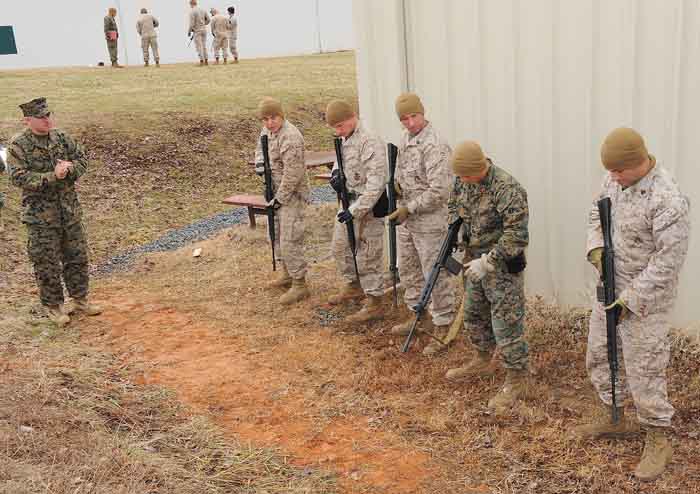
A big part of this mission is advising and training them in effective use of decidedly different small arms.
The need for preparing a rapidly growing number of Marines to teach foreign weapons employment was recognized early on in the Corps and was usually met by short term contracts with specialized civilian firms. This approach was found wanting in a number of ways, particularly with the urgent need to stand up the brand new Marine Corps Special Operations Command’s Foreign Military Training Units.
Not surprisingly, Quantico’s world-renowned Weapons Training Battalion got the mission to create and staff a dedicated course on foreign weapons.
WTBN’s Small Arms Weapons Instructor School put together the first Foreign Weapons Advisor Course, five days of instruction and range work that began in April 2007. Although necessarily brief and limited to a few relevant weapons that were scrounged from various sources, it included elements that would continue in follow-on versions.
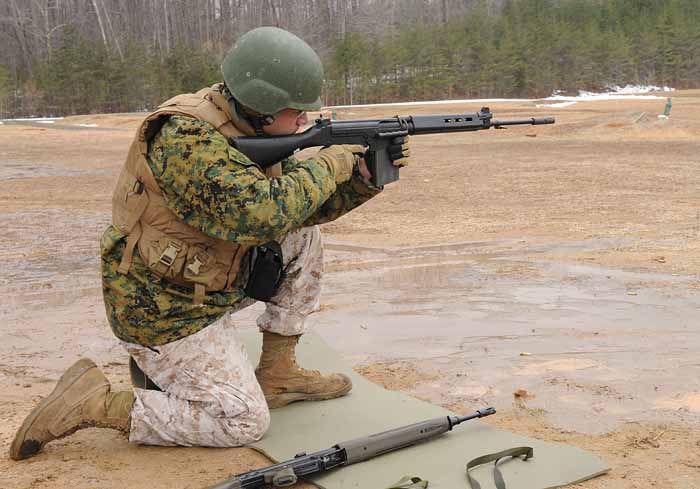
History, nomenclature, characteristics, stripping, assembly, and handling formed the basics. Then, practical live fire exercises from zeroing to multiple target engagements at various ranges with the AK series. When an “urgent need” procurement yielded additional weapons and adequate quantities of serviceable ammunition, live fire with SVD rifles as well as RPD and PKM machine guns was added.
To a certain degree graduates of these early courses were considered “subject matter experts,” but not particularly well equipped as teachers.
Student evaluations and input from deployed units were used to regularly update the course content. While quality improved, the number of graduates lagged behind requirements.
Foreign Weapons Symposium
The many challenges of increasing the number of Marines properly trained in Soviet-bloc and other weapons were examined in detail in a high level Foreign Weapons Symposium hosted by Marine Corps Training and Education Command in early 2007.
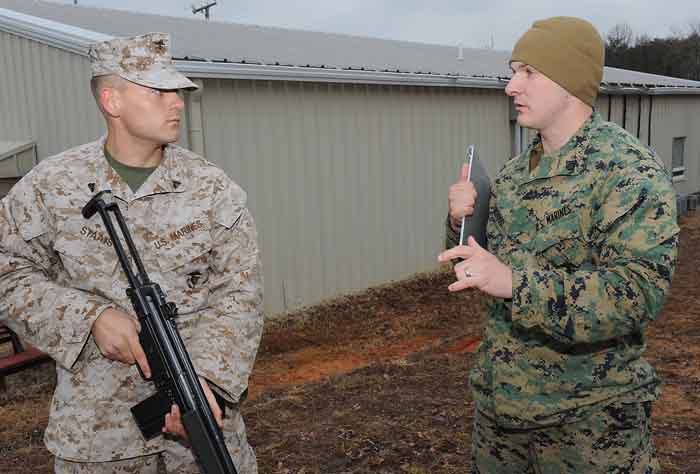
Symposium proceedings cited a number of glaring deficiencies in contractor-supplied courses including “exorbitant cost” (noted at $3,000 or more per student), lack of a standardized program of instruction and failure to incorporate the latest lessons learned in-country. No less damning was the assertion that time-honored Marine Corps techniques of instruction, with standardized terminology and deeply-ingrained weapons handling rules, were not consistently followed.
Participants recommended a series of fixes to address immediate requirements and to build capabilities over a longer term.
First up was identifying a list of foreign weapons that would be part of a standardized kit for instructional use. This included AK series rifles, RPD, PKM and DShKM machine guns. RPG-7 rocket launchers and Soviet model 82mm mortars would be added in certain specialized cases. Other weapons in general use by friendly countries were named as desirable but secondary to immediate needs.
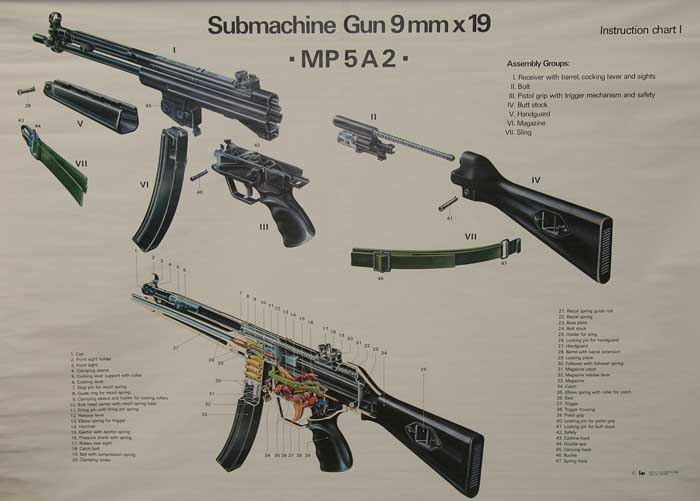
While priority was given to SAWIS and to the Advisor Training Group at Marine Corps Special Operations Command, the need for additional kits was recommended for each deploying infantry and artillery regiment, headquarters element for all divisions, and the Security Cooperation Education Training Center.
Realistic training goals were also addressed, with the recommendation that all deploying Marines have at least a basic familiarity with what they can expect to encounter in country. Three capability levels were defined, beginning with identifying and rendering safe common Soviet-type small arms. Level Two Marines would have a good level of proficiency in their use, and top level personnel would also be able to perform as certified instructors on these and other selected weapons.
Foreign Weapons Instructor Course
SAWIS implemented the symposium’s recommendations for Level Three capabilities by adding several days to what was already underway, recently renamed the Foreign Weapon Instructor Course. Now, FWIC students would have to go beyond demonstrating weapons proficiency to show they can effectively train both their fellow Marines and, with the aid of interpreters, foreign military forces.
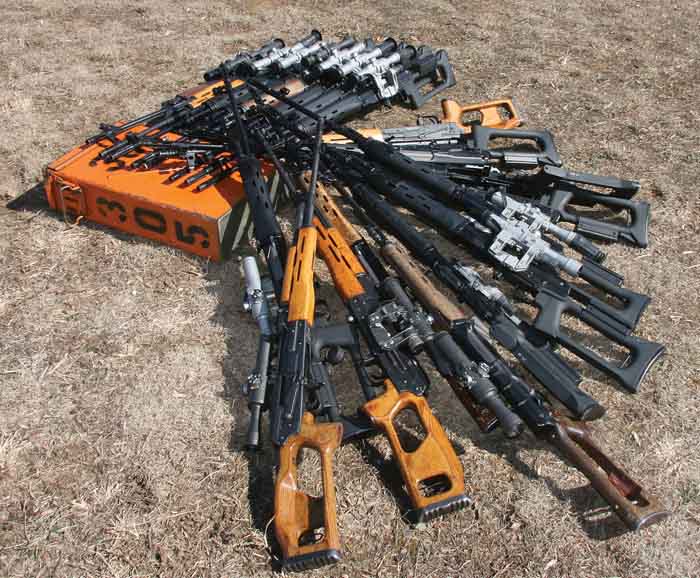
The newest program of instruction had just been put into effect when we visited FWIC the first week in March, 2010. It was Day 4 of the course and students had already been hit hard with POSA (Principles of Small Arms) beginning the first day with hours of classroom work, reinforced by plenty of after-class study.
28 well seasoned Marine NCOs and at least one officer – all with one or more deployments – were pretty much up to speed by the time we arrived on how weapons of all types worked. We found them comfortably seated in a classroom, paying close attention as Sergeant Andrew Gladue explained the ins and outs of the Soviet designed PKM, a medium machine gun roughly equivalent to the U.S. M240.
Each student had his own weapon on the desktop in front of him so they could follow along with Gladue’s narrative and a series of detailed PowerPoint slides projected on a large screen. They also had thick binders full of well prepared reference materials printed in full color, detailing the gun of immediate interest and all the other major and minor weapons that were part of the course.
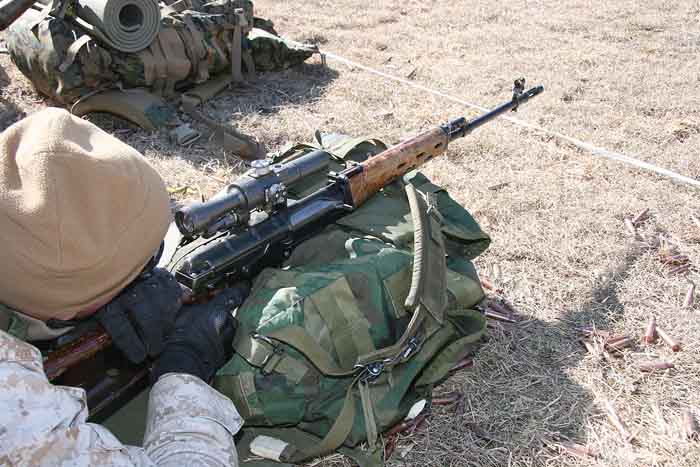
Gladue’s instructional style was a good balance of by-the-book facts plus interesting side notes, delivered in an almost conversational manner. He maintained attention by regularly asking questions and having his students handle their weapons as relevant points were made. Questions from the students were taken and responded to as they arose with no requirement to wait for a specified time.
This somewhat relaxed method was the norm in subsequent classes by other instructors we observed.
During a break we asked Gladue about this. “The students are experienced Marine leaders,” he said. “They’re here because they want to learn about the weapons. There’s no need for lectures.”
We learned that Gladue and other staff instructors were intentionally setting the example. When it came time for the students to “teach back” – to perform in the role of instructors – they were well advised to present the required information in the manner they had learned it themselves.
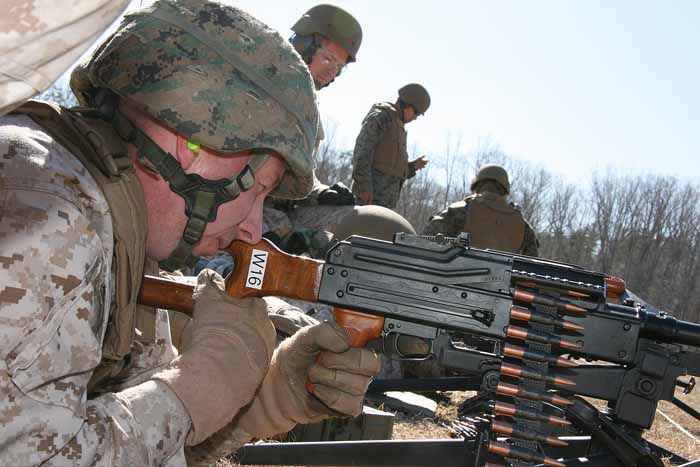
Hands-on
No matter how interesting the presentation, blocks of instruction in the classroom need to be reinforced by hands-on practical application time. In the particular instance we observed after Gladue had led the class through loading and unloading procedures, students grabbed their PKMs and filed outside.
They gathered into groups of four or five around their assigned instructor – always the same leader, always the same group. This is a well proven way, we’re told, to climb the learning curve by creating a relaxed setting where the instructor can recognize and work to overcome any weaknesses in his students.
With an icy wind inbound from WTBN’s nearby ranges, students got behind their guns with bellies down in the sparse winter grass and reddish clay, practicing what they had just learned inside. Then, under the watchful eye of their instructors, each student in turn went through the strictly specified sequence of steps to prepare the PKM for firing and render it safe and clear afterward.
Miss something? Do it again. And again as needed until it becomes second nature. Mastery of all the steps was a mandatory prerequisite before being granted the privilege of live fire.
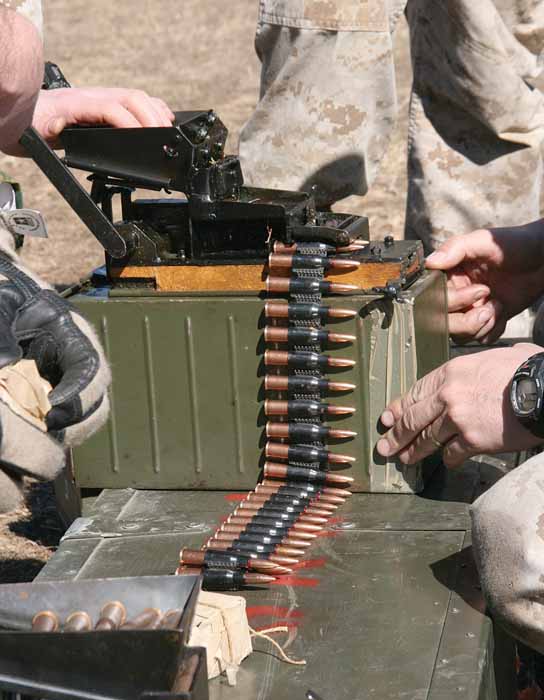
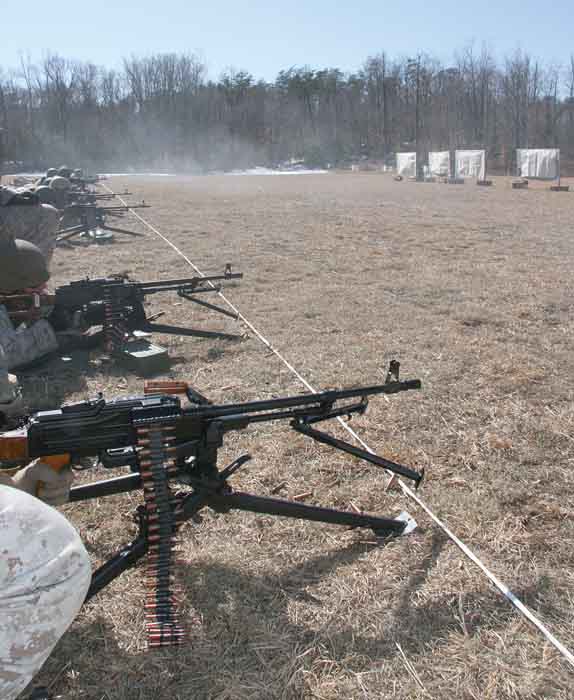
Range Time
The crawl, walk, run method of instruction is readily observed in the day’s training schedule where a morning packed with classroom and dry runs on the SVD sniper rifle and PKM machine gun was followed by the rewarding opportunity to put the guns to work.
WTBN boasts a superb selection of ranges right on site that don’t usually need to be shared with other units. We joined the class in progress on nearby Range 305 as they gathered around a loading machine they called the “meat grinder.” Marines accustomed to getting their machine gun ammo ready to go right out of the can were in for another lesson.
Foreign-marked wooden crates with tin “spam cans” of ammo were unsealed, paper packages were torn open and loose cartridges dumped into the machine’s hopper. Students took turns on the crank handle to mechanically insert formidable 7.62x54R cartridges into the PKM’s 50 round non-disintegrating metallic link belts.
Guns were brought up to the firing line mounted on tripods of the original Soviet design – surprisingly light but correspondingly flimsy – with a rather crude traversing and elevation mechanism. Following the usual safety briefing, delivered with practiced ease by Sergeant Joshua Orihood, one of the instructors; it was time to start burning powder.
Zeroing and the first course of fire were conducted at close range, just 12.7 meters, on the same scaled down targets familiar to Marine M240 and SAW gunners. This close proximity makes it easy to observe the strike of each burst and dial in necessary corrections to the sights without wasting a lot of time going back and forth to distant targets.
After several short bursts all the guns were properly zeroed and the rest of the course of fire was run on the little printed silhouette boxes with varying burst lengths and times. Qualification depended in getting the required number of hits in the right boxes and don’t fool yourself into thinking that’s easy.
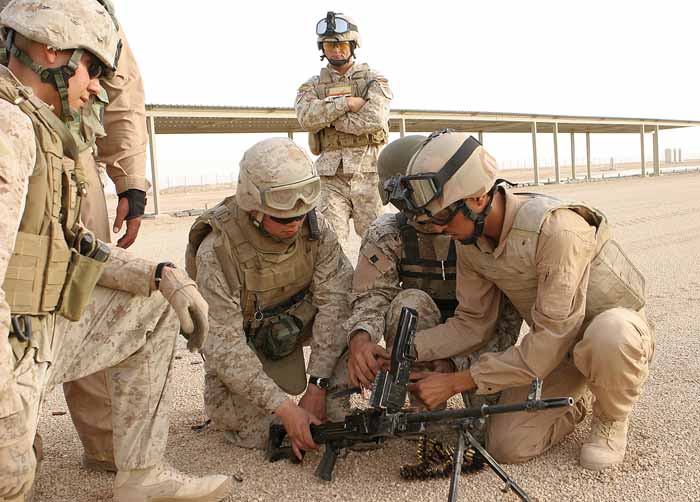
Snayperskaya
With PKM qualification checked off, it was time to move right into a course of fire with the fearsome Dragunov rifle, a Soviet-designed semi-auto, similar in form and function to the vintage U.S. M14 that has proudly returned to service in GWOT as the Marine Corps’ Enhanced Marksman Rifle. The EMR, by the way, is a product of the gunsmithing wizards at WTBN’s Precision Weapons Section.
While most any sniper rifle of AK pattern is all too often called an SVD (Snayperskaya Vintovka Dragunova), only the real Dragunov action rifles made in Russia or China qualify as “Dragunovs”. FWIC students damn sure know the difference and there were several variants noted as a dozen or so shooters dropped to prone on the firing line to zero rifles mounting various 4-power day scopes of PSO-1 type.
Zeroing was done at the 25 meter line using FWIC’s special multi-rifle targets that provide a small diamond-shaped aiming point surrounded by a numbered grid. Each time three rounds are fired, the center of the shot group is located and educated adjustments are made to the sights.
Done properly, subsequent three shot groups move to the correct location below the aim point that has been calculated for any particular weapon and its cartridge. This under-the-diamond shot pattern validates zero at close range in order to hit center of mass on man sized silhouettes at long range.
Confused? Sorry, there’s not enough space here for an explanation of line of sight and bullet drop. That’s your homework assignment.
After all shooters in both relays were satisfied with their zero, the whole group moved to the specified firing line on Range 305 for the rest of what had become a relatively warm and sunny afternoon of drilling life-sized plastic representations of hostile troops.
This can be a particularly satisfying exercise with any serviceable weapon because sensors on the target mechanism recognize vibration caused by passage of a bullet through the sturdy plastic target. Get a hit and the bad guy drops backward. Miss and everybody watching knows you’re a lousy shot.
While the SVD and its brothers aren’t tack drivers, the 4-power PSO-1 scope is no ACOG and the powerful 7.62x54mm rimmed ammo issued for this session was just ordinary ball, the task of hitting silhouettes with it at various distances out to just 300 meters is not considered daunting by the instructor staff and course standards. We’re told that everyone passed this evaluation.
Similar classroom, practice, zeroing, and field fire exercises are part of the course for the AK and RPD, counterparts to the M4 carbine and M249 SAW, as well as FN FAL and HK G3 rifles. These last two are contemporaries of the hard-hitting U.S. M14, all selective fire battle rifles that chamber the same powerful 7.62x51mm NATO cartridge used in the M240 machine gun.
Because each student will fire hundreds of rounds of three types of ammunition in the process of qualifying with all six weapons, ammo cost must be a significant factor.
With the fun stuff out of the way, the course moves into territory that many – instructors and students both say – find most challenging.
Role Reversal
Because FWIC graduates are expected to be called upon to plan, prepare and conduct live fire training at their home units, a good amount of time is spent teaching students all the unexciting but necessary administrative requirements. These include ordering ammunition, reserving ranges, preparing surface danger zone overlays, and a hundred other details contained in Marine Corps regulations and other sources.
All of this comes together in a student-conducted practical exercise in the second week with more live fire, this time on Range 15 in the boondocks of Quantico’s Camp Barrett area.
Well known to countless Marines going through TBS (The Basic School), this versatile range allows FWIC students to create innovative weapon qualification scenarios. Role-playing as instructors, the students take turns conducting classes in specified weapons and overseeing qualification firing.
Remember the four to five man groups? Instructors have been closely watching their students and, with the Range 15 ordeal behind them, the time has come to assign each one a specific weapon for a graded teach-back.
Sink or Swim
We returned to Quantico on the third and final week of the course to visit the section working with Staff Sergeant Ysac Perez. He and his Marines were off by themselves in one of WTBN’s many classrooms, individually reviewing their instructional notes and each with a different rifle sitting on the desk in front of him.
Perez explained that he and other section leaders usually assign specific weapons based on observations they’ve made during the course. This time around, Staff Sergeant Maximo Veliz, senior NCO in a scout-sniper platoon, was a natural for the straight-shooting SVD, Sergeant Justin Smallwood, a Force Recon team leader, drew the unusual G3, and Gunnery Sergeant Phillip McMellon, staff NCO in School of Infantry East, had the generic AK. Sergeant Alex Deykerhoff, the rifle squad leader whose quote leads this feature, was presented with the elegant FAL, not coincidentally his “new favorite battle rifle.”
We sat in on each of their instructional practice runs as Perez made notes on a standardized evaluation form. A constructive verbal critique followed, reinforcing good points and pointing out what needs improvement.
The process was to be repeated as many times as necessary to get it right before the evaluation-for-record that would take place the next day. Demonstrating the ability to instruct Marines and others in foreign weapons is the essence of this particular version of the course, and a final hurdle to be cleared for graduation.
As Perez explained to us later, style and delivery were important, but not so much as “hitting all the wickets,” to make sure all key points were addressed in an effective manner. Prominent among these, he said, are clearing the weapon before handling it, historical background and current users, characteristics, nomenclature, assembly and disassembly, loading, zeroing, and firing positions.
All of this and more is clearly and logically presented in each student’s reference binder. The trick, it seems, is to present the important stuff using a single page of notes and not going over the allotted time.
Informal Round Table
In the course of several hours spent with Perez, his students and others, we caught a number of things that bear mentioning. A few highlights:
- FWIC graduates don’t get formal promotion points or an ASI (Additional Skill Identifier) to their Military Occupational Specialty. All said their motivation to attend what they called this “unit enhancing course” was to teach other Marines about the foreign weapons they are likely to encounter on deployment.
- Even self-professed “gun nuts” find the intensive block of instruction in Principles of Small Arms to be challenging and rewarding. The range of very different operating systems is an eye-opener and it develops a deeper appreciation for weapons in general and current-issue U.S. small arms in particular.
- One student, a Recon Marine, said the weapons recognition part was highly relevant to men in his trade with its strong focus on surveillance and intelligence-gathering. “If you find an AKSU-74 (Russian special operations assault carbine), then you know you’re dealing with a top dog kind of unit.”
- These experienced Marine NCOs were uniform in their praise of the content of the course and professionalism of the instructional staff.
- Mindful of the requirement to provide a concluding written evaluation, there was brisk discussion of ways to make the course better. While there was general agreement that more time ought to be devoted to weapons handling and live fire, the “train-the-trainer” part got mixed reviews.
- Perez confirmed that this was the first and last three week version of FWIC. Word has come down through the chain-of command that much of the “how to teach” time was out and the course would revert to two weeks. In a follow-up conversation with Staff Sergeant James Snyder, Staff NCOIC of SAWIS, he explained that training in instructional techniques was well covered elsewhere; in mandatory schools for career progression and in the online course that’s a prerequisite for attending FWIC. Also, he said, there is an urgent need for more Marines trained in foreign weapons and the current output of 160 per year is ramping up to 300.
- Cutting back on student as teacher part has its own benefits. 80 hours of concentrated training are packed into two weeks, allowing more time for hands-on and several new weapons are being added. “The ‘other weapons’ part of the course,” Gladue told us, “will grow to include the HK MP7 and FN P90 personal defense weapons, Walther P38 and Mauser C96 pistols, Israeli Negev SAW, and Russian RPK auto rifle.”
Oh, we shouldn’t fail to mention there’ll be some up close and personal time with the iconic Thompson submachine gun.
Parting Shot
“You might think you’re going over there to chase the bad guys but when you get there the mission could change and you’re training the Afghan National Army or Iraqi soldiers. If you don’t have the knowledge to teach these weapon systems you’re already behind.” Gunnery Sergeant Phillip McMellon, student, FWIC
Get in the Pipeline
Slots are limited and a lot of Marines are already lined up to get in. FWIC is open to Marine NCOs in the rank of Corporal to Master Gunnery Sergeant, to officers up to Major, and Chief Warrant Officers. Priority is given to Marines in 03xx and 02xx Military Occupational Specialties but others may attend with special approval. Prerequisites include documented weapons qualification levels and completion of courses in weapons safety and instructor skills. Details are available on WTBN’s website at www.tecom.usmc.mil/wtbn/schools/fwic/prerequisites.asp
| This article first appeared in Small Arms Review V13N10 (July 2010) |






